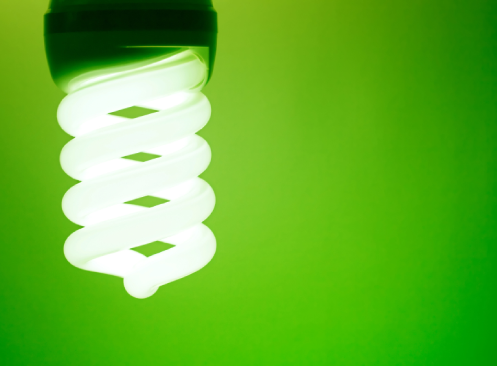There are so many different lighting options available in the world today. Most of them are designed with aesthetics in mind. This is fine, but if you are looking to reduce the amount of money you spend on electricity bills and your carbon footprint, you should consider energy-efficient lightbulbs.
Understanding How Energy-Efficient Lightbulbs Work
There is a popular law of physics that says that you cannot destroy or create energy, but you can convert it from one form into another. The traditional, energy-consuming lightbulbs heavily rely on this law. The electric current is passed through a thin wire made of tungsten metal (the filament), which turns it into heat. The filament becomes so hot that it glows, producing light. The hotter you make the filament, the brighter it shines. Traditional lightbulbs have argon, an inert gas, which protects the filament while it is hot. If there were any other gas like oxygen or hydrogen, it would react with the hot tungsten material, quickly destroying it.
Traditional lightbulbs waste a lot of energy because they have to produce as much heat as possible to produce light. Only 10% of the heat produced is converted into light, and 90% goes to waste. Therefore, if you want to make it more energy-efficient, you can either turn more of that heat to light by making the most of it or reduce the amount of heat produced.
Modern energy-efficient lightbulbs have found a way to reduce the amount of electricity used to produce the same or better light than the traditional bulbs. For instance, they have added different compounds to mix: mercury vapor, electronic ballasts, and fluorescent coating. The electric current passes through the electronic ballasts when the light is switched on. This current causes mercury vapor to produce invisible ultraviolet light. This UV light excites the fluorescent coating, causing it to produce light. In this process, 70% of energy is utilized, and only 30% is wasted.
Types of Energy-Saving Lightbulbs
1. Light-emitting diodes (LEDs)
LED bulbs are people’s first choice when thinking about energy-efficient lightbulbs. People love LED because they produce very little heat and convert 90% of it into light. On top of that, they have a lifespan of up to 34 years.
LED lights work a little differently from the other types of energy-efficient lightbulbs. Instead of producing heat, LED lightbulbs produce light particles, known as photons, when electricity passes through a semiconducting material. This is what makes them very energy efficient; electric current is converted to photons and not heat.
Pros:
- Using LED bulbs will save you up to 80% in energy costs annually.
- They are not sensitive to temperatures or cold climates.
- They have a longer lifespan than all the other types of lightbulbs.
- They will still be cool to the touch after using them for hours.
- They provide instant bright light when turned on.
Cons:
- Compared to other lightbulbs, they are the most expensive.
- They contain blue light.
- When turned off, they take time to dim in brightness.
2. Compact Fluorescent Lamps (CFLs)
Known for their famous spiral-shaped tubes, CFLs were the first real energy-saving bulbs to be produced. They use the technology of fluorescent bulbs, where phosphors are involved. Even though heat is produced to make light, unlike in LED bulbs, this heat produced is very minimal and thus saves you a lot of money on electricity bills.
Pros:
- They are cost-effective thanks to their energy-saving capabilities.
- CFLs are available in a variety of hues, including bright, warm, and soft.
- They generate evenly spread illumination.
- They can last up to 10 years.
Cons:
- They contain mercury, making it difficult to dispose of them.
- You cannot use them with a dimmer switch.
- They light up progressively, not at once like LED bulbs.
- CFLs are sensitive to colder temperatures and will not work under 32 degrees Fahrenheit.
CFLs are sensitive to cold temperatures because they need heat to stimulate the mercury, which in turn excites the phosphors to produce light. When the temperatures are too low, it becomes difficult for it to produce the amount of heat needed to stimulate the mercury vapor.
3. Halogen incandescent
Although these types of bulbs are being phased out, they are also good at energy saving. People also love them because they give the appeal of traditional incandescent lights while still managing to save energy.
Halogen incandescent lightbulbs work the same way as traditional bulbs, but it uses halogen gas to enhance its effectiveness. The halogen redeposits the particles of tungsten filament back onto it. This ability to make those particles to be reused saves energy and gives the bulb a longer lifespan than the traditional ones. They can last for three months.
Pros:
- They are safe to dispose of.
- They produce bright light than traditional bulbs but with lesser energy, about 25%.
- Halogen incandescent bulbs create a relaxing yellow tone.
- When turned on, they produce full illumination capacity instantly.
- They give the same aesthetics as the traditional lightbulbs.
Cons:
- Touching the bulb can reduce its lifespan by interfering with its process.
- They generate high heat when working.
The Best Energy-Efficient Lightbulbs
Best LED Lightbulb – Cree Lighting Exceptional Series A19 Bulb, 60W
Cree is known to be one of the best manufacturers of lightbulbs on the market today. This light bulb is affordable, durable, and energy-saving. They consume only 10 watts of energy while producing 815 lumens of light. This means that one led bulb with bright light will only cost you $1.83 per year.
Key Features
- They produce a smooth, dimmable light.
- They are versatile and can be used in a ceiling fan, pendants, sconces, table lamps, and floors.
- They are an all-round light that can light up every corner of your room as you want them to.
Best CFL lightbulb – Philip 60-Watt Equivalent CFL Twister Light Bulb
CFL bulbs are also a good choice if you are looking to save energy and reduce your carbon footprint. They are long-lasting. They will last for about nine years if you use them for three hours a day. Twister produces 860 lumens, which is brighter than Cree and consumes only 13 watts. This means that they will cost you about $2.4 in energy bills per year.
Key Features
- Produces 860 lumens brightness
- Uses only 13 watts to produce full brightness
- Lasts 9.1 years average lifespan
Best Incandescent – GE Incandescent A21 Light Bulb
If you love incandescent lightbulbs, then the GE Incandescent A21 is for you. They give your room a warm glow, can be used with a dimmer, and are relatively less expensive.
Key Features
- They emit a warm, soft white light.
- They can last for approximately one year with 3 hours of daily usage.
- Incandescent A21 is ideal for workplaces, bathrooms, and kitchens.
If you live in Sacramento, El Dorado, Placer, San Joaquin, and Yuba counties, call Huft Home Services of Elk Grove, CA, if you are experiencing any electrical issues in your home. From something as simple as flickering light to a whole-home rewiring, we’ve got you covered. We also offer a wide range of heating and cooling services. We have an expert team, rapid response time, and world-class customer service that ensures you get first-class service every time.




